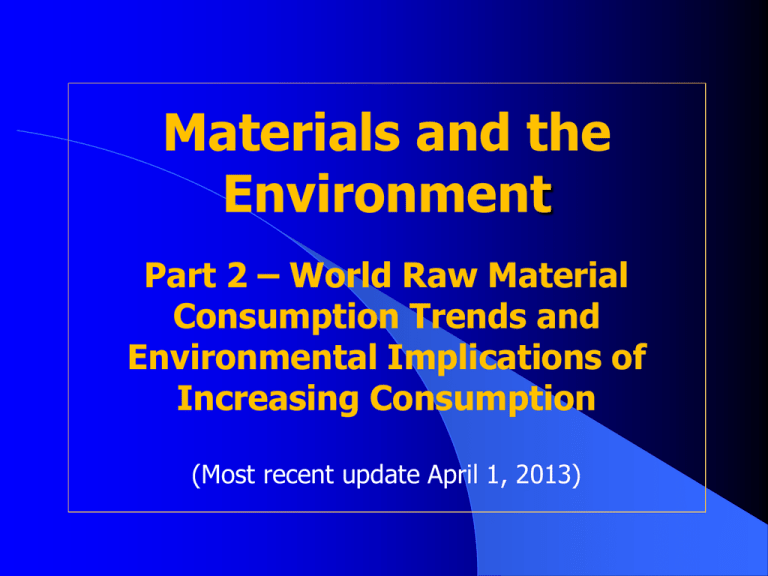World Raw Material Consumption Trends and Environmental
advertisement

Materials and the Environment Part 2 – World Raw Material Consumption Trends and Environmental Implications of Increasing Consumption (Most recent update April 1, 2013) World Raw Material Consumption Trends Molybdenum mining in Colorado World Raw Material Consumption Trends • • World and U.S. populations are growing. World economic growth is much more rapid than the rate of population growth – as a result, per capita consumption of goods of all kinds is rising globally. World Demand for Selected Raw Materials, 1961 – 2012 Materials Used in Greatest Quanity (Million Metric Tons) 8000 7000 6000 Raw Steel Ind. Wood Fuel Wood Cement 5000 4000 3000 2000 1000 2012 2009 2006 2003 2000 1997 1994 1991 1988 1985 1982 1979 1976 1973 1970 1967 1964 1961 0 Source: U.S. Geological Survey, Commodity Summary Statistics (2013). Data for wood from UN, FAOStat Forestry (2013). World Demand for Selected Raw Materials, 1961 – 2012 Important Metals (Million Metric Tons) 90 80 Tin Nickel Lead Zinc Copper Aluminum 70 60 50 40 30 20 10 2012 2009 2006 2003 2000 1997 1994 1991 1988 1985 1982 1979 1976 1973 1970 1967 1964 1961 0 Source: U.S. Geological Survey, Commodity Summary Statistics (2013). World Growth in Consumption of Principal Raw Materials, 1961-2012 (Population growth during this period: 2.28x) Steel Cement 4.26x 11.10x Aluminum Plastics Wood 9.45x 48.33x 1.60x Source: Data for wood from FAO (2013); for cement, steel, and aluminum from the U.S. Geological Survey (2013); and for plastics from the Association of Plastics Manufacturers in Europe (2013). U.S. Demand for Selected Raw Materials, 1961 – 2012 Materials Used in Greatest Quantity Great recession (Million Metric Tons) 500 450 400 350 300 250 200 150 100 50 0 2012 2009 2006 2003 2000 1997 1994 1991 1988 1985 1982 1979 1976 1973 1970 1967 1964 1961 Tin Nickel Lead Zinc Copper Aluminum Raw Steel Wood Cement Source: U.S. Geological Survey, Commodity Summary Statistics (2013). Data for 2010-2011 wood consumption from UN, FAOStat Forestry (2013); 2012 est. If a full array of raw materials, including industrial minerals (limestone, clay, sand, gravel), are added to a graphic of materials consumption growth, the picture is even more dramatic. U.S. Raw Nonfuel Minerals Put into Use Annually from 1900 through 2010 (materials embedded in imported goods not included) Source: U.S. Geological Survey (2012). U.S. Raw Raw Materials Put into Use Annually from 1900 through 2010 (materials embedded in imported goods not included) Source: U.S. Geological Survey (2012). In the next slide, raw material consumption growth is shown for two time periods for the United States: 1961-2005 and 1961-2012. Note the dramatically different numbers – pre-great recession and with the recent recession included within the time frame. Consumption patterns are likely to soon return to the 1961-2005 pattern. U.S. Growth in Basic Raw Materials Consumption, 1961-2005 and 1961-2012 Steel Cement Aluminum Plastics Wood Population growth 1961-2005 – 1.61x ‘61-’05 1.68x 2.26x 3.48x 49.90x 2.37x Population growth 1961-2012 – 1.71x ‘61-’12 1.51x 1.39x 2.63x 42.40x 1.57x Source: Data for wood from USFS and estimates (2013); for cement, steel, and aluminum from the U.S. Geological Survey (2013); and for plastics from the National Commission on Materials Policy (1975) and the American Plastics Council (2013). Principal raw materials globally and in the United States are cement, wood, and steel. Annual World Consumption of Various Raw Materials, 2011 Cement Roundwood Industrial roundwood* Steel Plastics Aluminum Billion Metric tons 3.600 1.739 0.794 1.520 0.280 0.044 Billion m3 1.1 3.5 1.6 0.19 0.31 0.01 * The difference between roundwood and industrial roundwood is wood used for fuel. Roundwood includes both fuelwood and wood used in construction, and for making paper, furniture, and other wood products. Source: Data for wood from FAO (2013); for cement, aluminum, and steel from the U.S. Geological Survey (2013); and for plastics from the Association of Plastics Manufacturers in Europe (2013). Annual U.S. Consumption of Various Raw Materials, 2011 Million Metric tons Roundwood* 145 Forest products (wood only) 128 Cement 72 Steel 90 Plastics 47.5 Aluminum 3.6 Million m3 341 300 23 12 53 1.3 * Roundwood is the volume of all wood harvested. More wood is consumed every year in the United States than all metals and all plastics combined. Source: Data for wood from UNECE (2013); for cement, steel, and aluminum from the U.S. Geological Survey (2013); and for plastics from the American Plastics Council (2012). In view of this high and continuing rate of consumption, does this mean that the world is likely to soon run out of essential raw materials? The good news is that the world is unlikely to physically run out of most types of raw materials anytime soon. However, there are a number of factors that may combine at some point to limit availability of critical resources. These include rising competition among nations and regions for resources, social issues, and environmental concerns. Consider Mineral Resources Mineral resources have become more and more widely available despite (and partly because of) growing rates of consumption. Ore quality is declining as consumption of metals rises. Highest Grades of Ore (generally exploited first) Lower Grades of Ore Lowest Grades of Ore High quality ore contains a high percentage of metallic element in a given amount of ore. Low quality ore contains a low percentage of metallic element in a given amount of ore. Note: products that originate from low grade ore are not inferior in quality to products that originate from high grade ore. There is a strong tendency for mineral resources to increase in quantity as the quality that can be economically exploited goes down. There is a strong tendency for mineral resources to increase in quantity as the quality that can be economically exploited goes down. Highest Grades of Ore (generally exploited first) Decreasing ore quality Lower Grades of Ore Lowest Grades of Ore Increasing ore availability Reserves of metals are typically expressed in years . . . or specifically as World Reserves Indices To calculate the World Reserves Index, known reserves of a mineral that can be • extracted economically • at today’s prices • using today’s technology are divided by current annual consumption of that mineral. World Reserves of Selected Metals (expressed in years of supply) Metal Reserves (years) Iron Ore 178 Aluminum Zinc 219 19 Manganese Lead 43 20 Copper 35 Nickel 51 Uranium 65 Titanium 79 Source: Richards, J. 2009. Mining, Society, and a Sustainable World. These numbers are sometimes interpreted as indicating that the world is about to run out of minerals. However, World Reserve Index values tend to remain constant or even rise over time. Nothing said here should be interpreted that all metals are infinitely available. Also, while long-term availability of most metals is not an issue, the environmental impacts of procuring and processing ore, and especially increasingly lower grades of ore, present significant challenges. Environmental concerns related to mining and metals production center on long-term impacts to nearby populations, landscapes, water supplies, and air quality and large impacts of conversion of ore to base metals and useful products. Consider Wood Resources Wood is a renewable resource. It is infinitely renewable as long as the forests from which it is obtained are managed sustainably. There are about 4 billion hectares (10 billion acres) of forests in the world. While forest area is declining in some parts of the world, it is stable or increasing in others. Decreasing Stable or increasing Similar trends can be seen in forest carbon stocks. Source: United Nations, FAO, Global Forest Resources Assessment, 2010. Planted forests now make up about 7% of the total forest area globally – 264 million hectares (652 million acres). These supply about one-quarter of the annual harvest of wood used for forest products. Deforestation is ongoing, but at a declining rate worldwide. Losses are wholly within tropical regions Estimated Deforestation by Type of Forest and largely and Time Period attributable to conversion to agriculture – although other factors, including indiscriminate logging, play a Source: United Nations, FAO, State of the World’s Forests – 2012. role. In the United States, the World’s Largest Producer and Consumer of Wood Products: • Forest cover is within 1% of what it was in the early 1900s (33% of the land area). • • • • Net growth greatly exceeds removals. Forest inventory is increasing. Forest carbon stocks are increasing. Ongoing technology improvements have greatly increased the efficiency of wood use – now 99%+ of each log harvested. Trends in U.S. Forestland Area 1630-2009 1200 1045 Million Acres 1000 800 759 732 760 756 762 755 744 739 737 747 751 600 400 200 0 1630 1907 1920 1938 1953 1963 1970 1977 1987 1992 1997 2009 Source: USDA – Forest Service, 2009. U.S. Timber Growth and Removals, 1920 - 2006 30 Billions of cubic feet/ year 25 20 Net Growth Removals 15 10 5 0 1920 1933 1952 1976 1986 1996 2006 Figures above only include growth on forest land where periodic harvesting is allowed. Growth in reserves, parks, and wilderness areas is not included. Source: USDA - Forest Service Standing Timber Inventory – U.S. 1952-2007 Billion Cubic Feet Hardwoods Softwoods 1000 900 800 700 600 500 400 300 200 100 0 1952 1962 1970 1976 1986 1991 1997 2002 2007 Inventory only includes forest land where periodic harvesting is allowed. Timber volumes in reserves, parks, and wilderness areas are not included. Source: USDA-Forest Service, 2007. Forest Soil Carbon Inventory, U.S. 1990-2010 Soil Organic C Litter Dead Wood Belowground Biomass Billion Tons Carbon Aboveground Biomass 45 40 35 30 25 20 15 10 5 0 1990 1995 2000 2005 2010 Source: USEPA (2012). Inventory of US Greenhouse Gas Emissions and Sinks, 1990-2011, p. 7-15. Percent of Log Volume Entering Sawmill A History of Wood Utilization Efficiency in the U.S. 100 90 80 70 60 50 40 30 20 10 0 1930 Energy Production Other Products Lumber 1970 1985 2005 Source: Bowyer (2012). Data for United States, 2005. Uses of Material Processed at U.S. Milling Sites - 2005 • • • • 52% processed into lumber. 36% converted to paper, particleboard, fiberboard, insulation board. 11-12% used to generate energy. ≤1% waste. Source: Bowyer (2012). Data for United States, 2005. Consider the following illustration of the renewable nature of forests – and of the wood that they produce. U.S. Population Annual Wood Harvest stock Between 1952 volume and 2007, timberincreased by harvests over 50%! increased by 3.8 billion cubic feet 1952 annually. So 2007 what happened to the volume of growing in U.S. forests? Billion ft3 Million m3 1000 900 800 700 600 500 400 300 200 100 0 Millions U.S. Population, Wood Harvest, and Net Forest Growing Stock Volume, 1952 and 2007 Growing Net Growing Stock Volume Annual wood harvest expressed in m3 and growing stock in ft3 to fit to axes. Source: U.S. Census Bureau, 2005; U.S. Forest Service, 2004. Environmental concerns linked to forest harvesting center around fears of deforestation and effects on forest values other than wood. Summary Summary • Consumption of both renewable and non- renewable raw materials is increasing. • Ongoing improvements in technology and informed management has allowed resource availability to keep pace with increasing consumption. • The world will not “run out” of raw materials anytime soon, though there are concerns about future availability of some key minerals. Summary • With sustainable management (such as practiced in the United States), forests – and the wood that they produce, will never run out. • Environmental concerns related to rising resource use are increasing.








